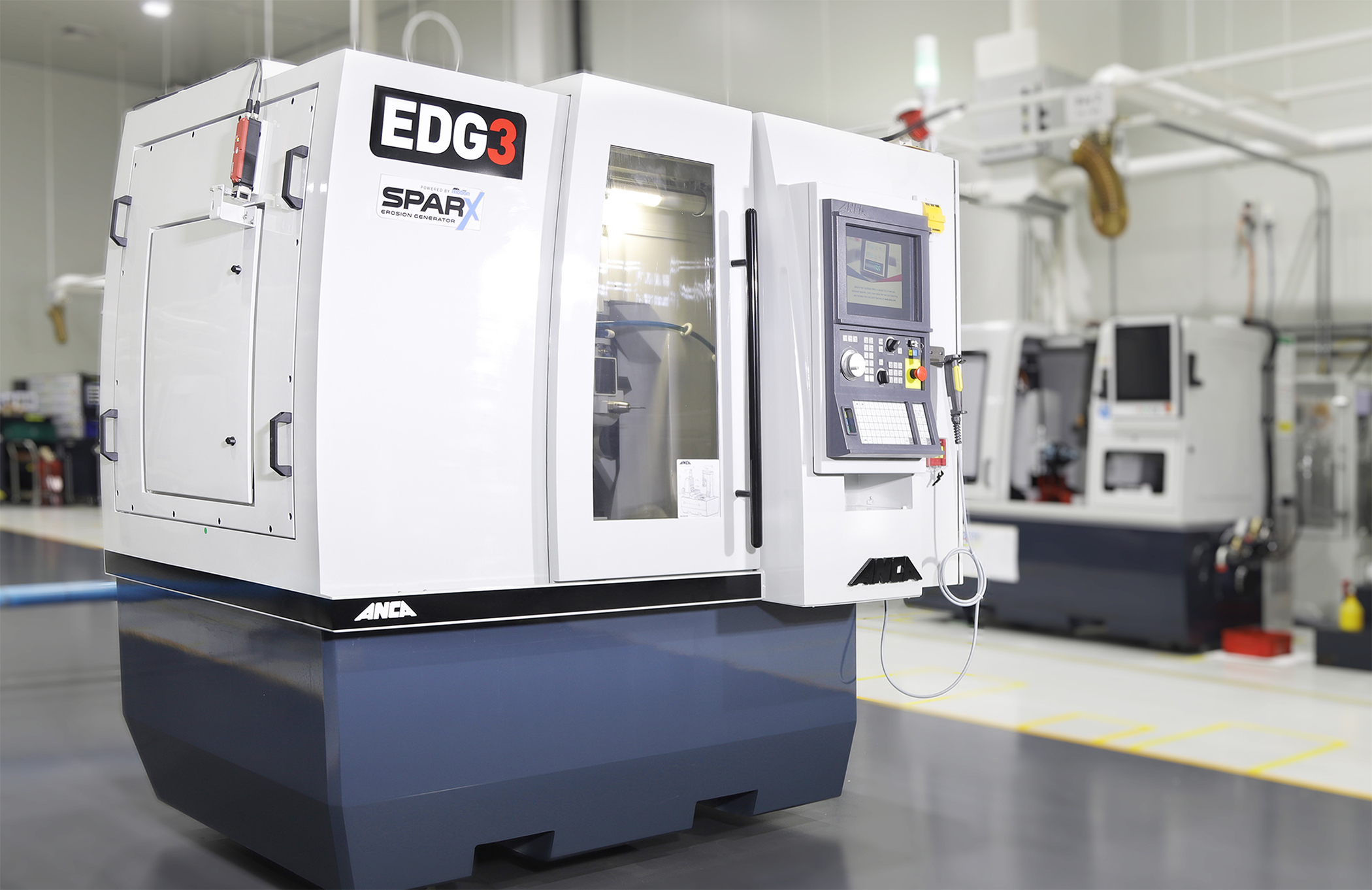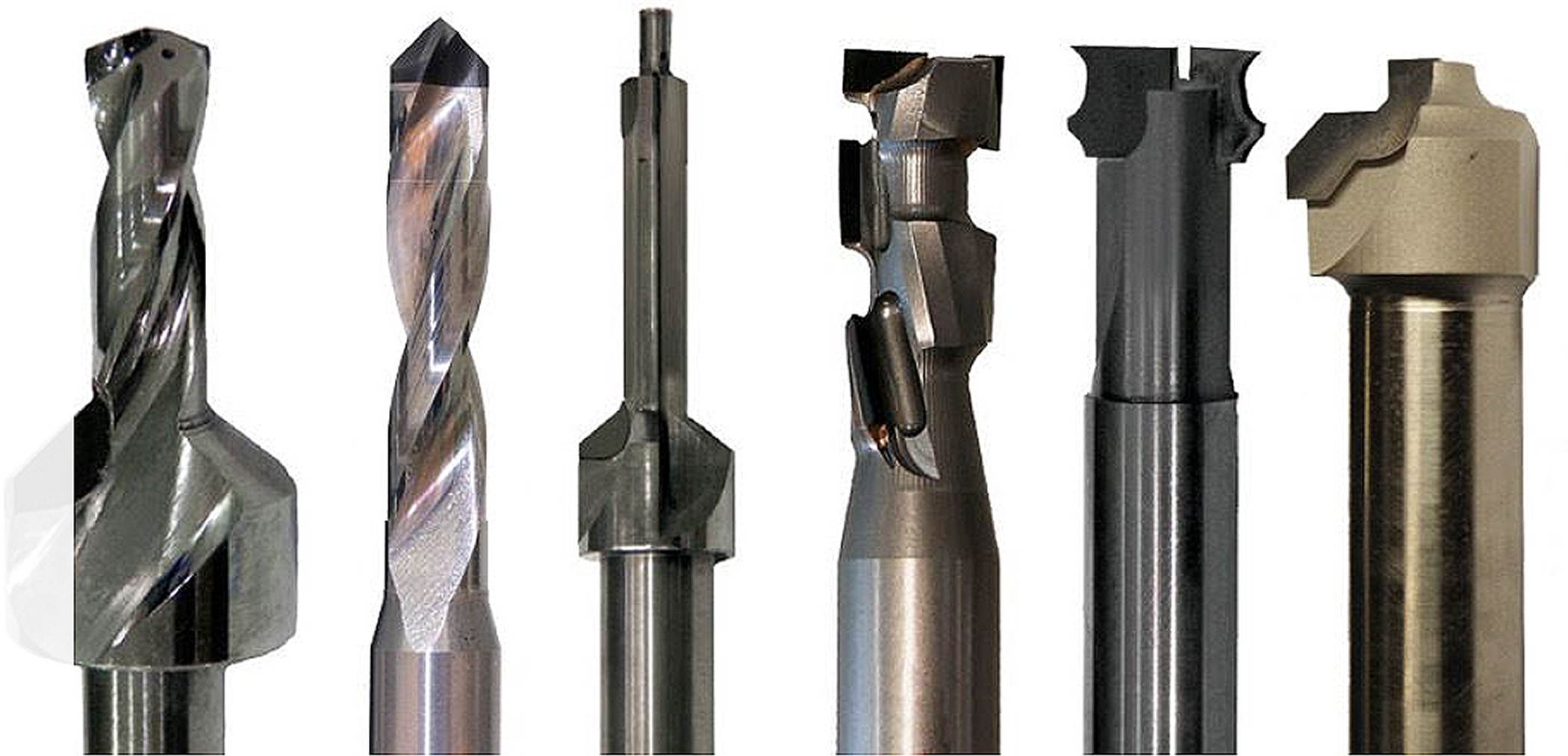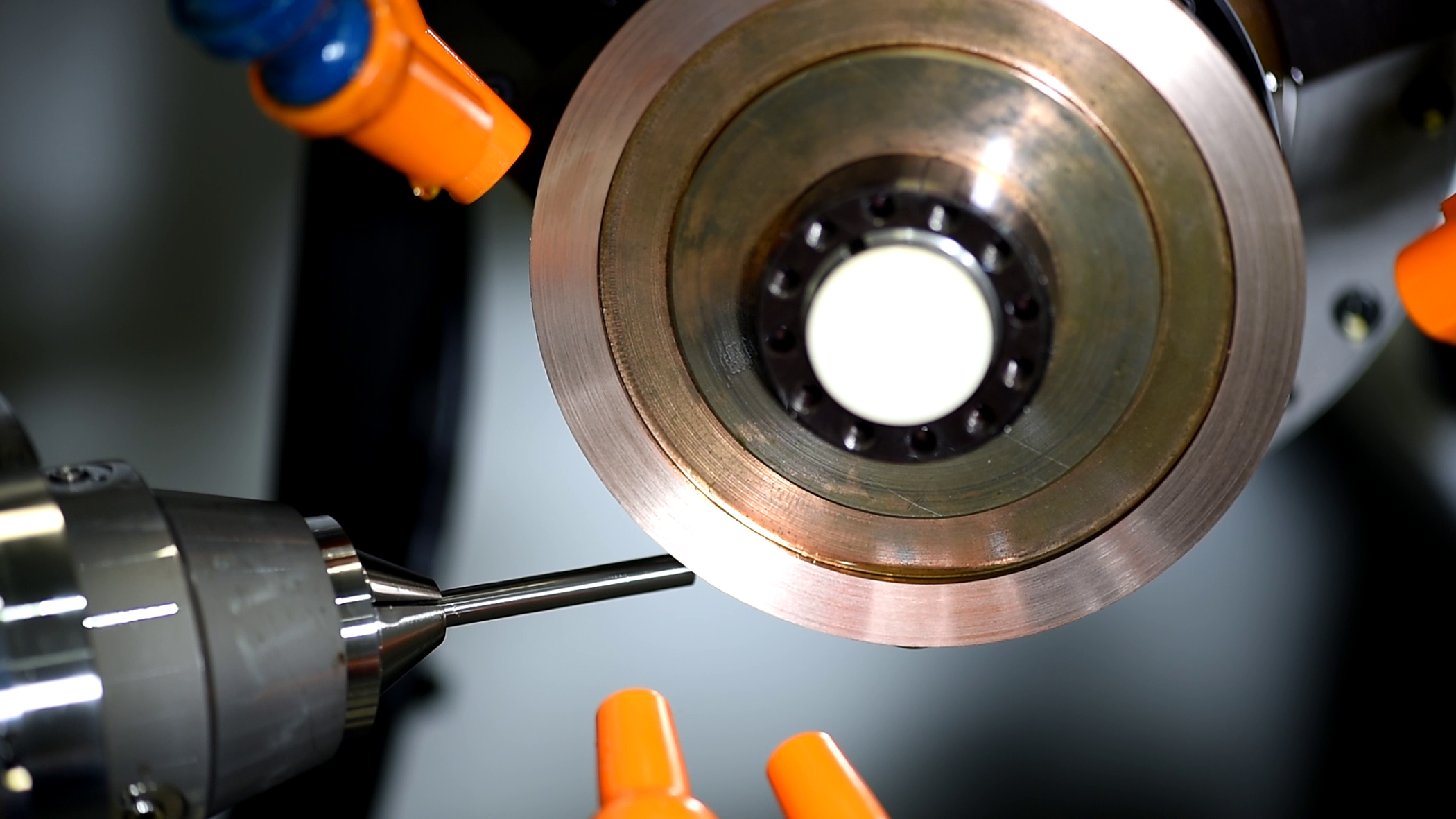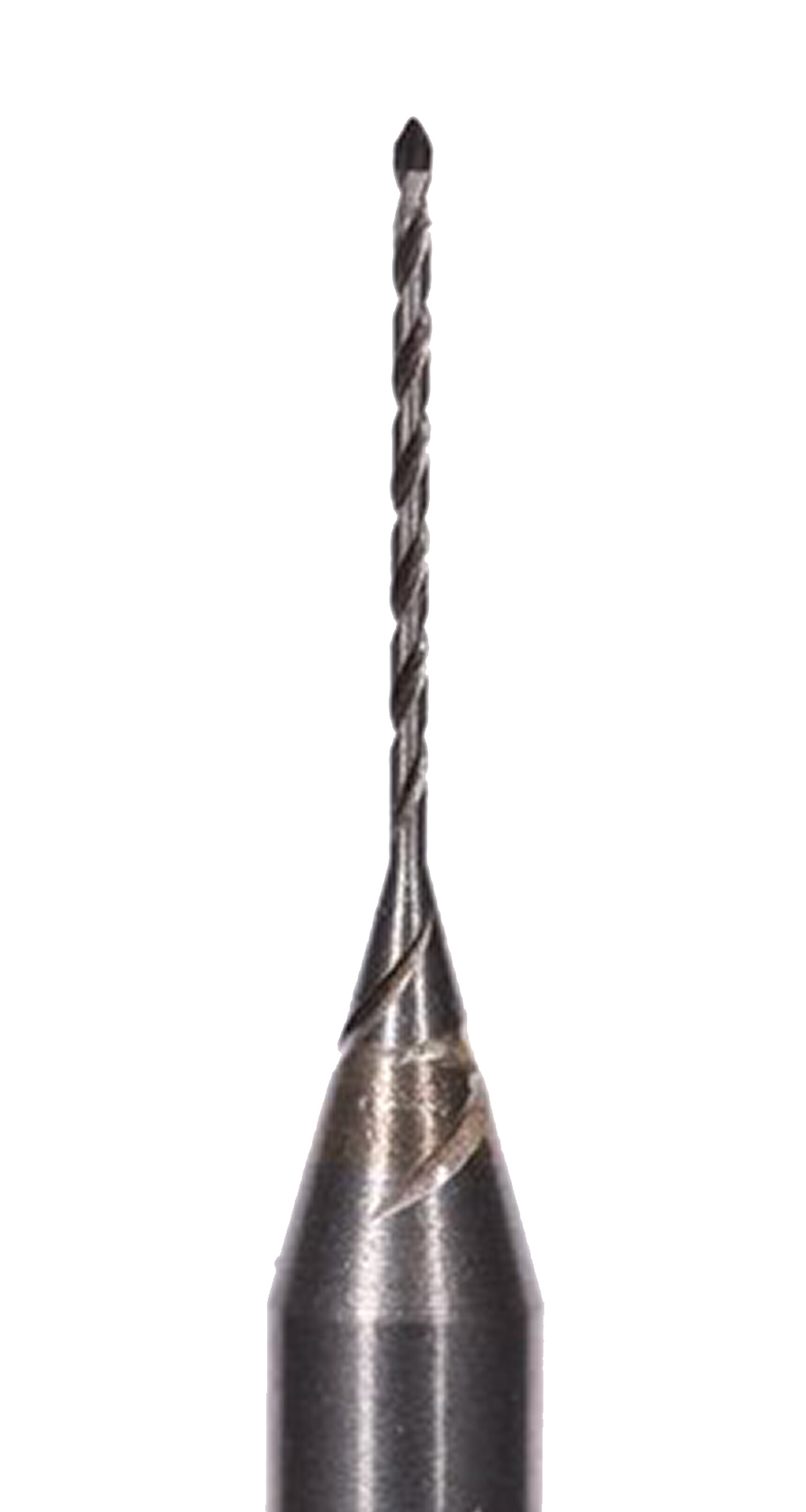By Tom Nathan, ANCA PCD Erosion Product Manager
 Utilizing intelligent and adaptive control and monitor technology, ANCA CNC Machines has developed a new electro discharge grinding (EDG) machine that monitors and controls sparks and the erosion gap to decrease cycle times for PCD tools by 50%.
Utilizing intelligent and adaptive control and monitor technology, ANCA CNC Machines has developed a new electro discharge grinding (EDG) machine that monitors and controls sparks and the erosion gap to decrease cycle times for PCD tools by 50%.
In 2011, when ANCA decided to create the ANCA EDG , the company wanted to create a high-performance Rotary Electro Discharge Machining (EDM) platform that was not only able to produce best-in-class tool geometries, but also have market leading cycle times.
“The erosion process is simple in its complexity,” said Pat Boland, ANCA founder and managing director. “The basis of the process uses positive and negative electrodes with electrolyte to create sparks along a material. ANCA has a 45-year history in making the world’s best carbide and HSS tools and we wanted to use that skill set in PCD tooling.”
 The main drivers behind the ANCA EDG machines were that it needed to be simple enough for all types of brazed shear-fluted tools, but complex enough to enable the creation of the infinite variety of helical solid-tipped, veined and chevron tools.
The main drivers behind the ANCA EDG machines were that it needed to be simple enough for all types of brazed shear-fluted tools, but complex enough to enable the creation of the infinite variety of helical solid-tipped, veined and chevron tools.
“We realized early on that with the complexity of tool geometries we wanted to allow our customers to create, the 5-axis interpolation while maintaining the precise erosion gap distance was going to be a challenge, he said.”
Maintain an optimum spark erosion gap
The ANCA EDG is able to maintain the optimum spark erosion gap for both simple 2D and complex 3D path interpolations, which is fundamental to the process working with high efficacy. This is very simple for 2D paths. However, when 3D path interpolation involves 4 or 5 axes moving simultaneously, than surface area, volume and path variation become a challenge. From testing, we knew that the standard was to set the machine feed rate to the lowest allowable rate to maintain a useable spark gap distance; however, this leads to a lot of ‘air-time’ and drastically lowers efficiency. To allow the feed rate to remain high and maintain the optimum spark erosion gap, the idea of Intelligent Adaptative Control (IAC) was born.
 Intelligent Adaptive Control (IAC) is an in-time, servo-controlled feature that automatically monitors and controls the erosion gap distance, in-process. Utilizing the EtherCAT functionality of the ANCA Motion AMD5x control system, IAC synchronizes the machine moves with the generator performance. IAC adjusts and maintains the optimum spark gap which is vital while eroding 3D geometries such as PCD flutes and gashes on drills and endmills. With geometry changing in up to 5-axes at once, IAC automatically adjusts the gap distance and machine feedrate to optimize the erosion speed and surface finish. This involves not only speeding up feedrates when erosion is along linear paths but also slowing down feedrates when path changes occurs.
Intelligent Adaptive Control (IAC) is an in-time, servo-controlled feature that automatically monitors and controls the erosion gap distance, in-process. Utilizing the EtherCAT functionality of the ANCA Motion AMD5x control system, IAC synchronizes the machine moves with the generator performance. IAC adjusts and maintains the optimum spark gap which is vital while eroding 3D geometries such as PCD flutes and gashes on drills and endmills. With geometry changing in up to 5-axes at once, IAC automatically adjusts the gap distance and machine feedrate to optimize the erosion speed and surface finish. This involves not only speeding up feedrates when erosion is along linear paths but also slowing down feedrates when path changes occurs.
Twists and turns along the erosion path leads to scenarios where the electrode wheel is likely to come into close contact with the tool, or comes off the tool. This can lead to optimal, bad and missed sparks along the trajectory. IAC automatically accounts for this and maintains the fastest possible feedrate along the length of any changeable path. This results in increased feedrates, minimum thermal damage, superior surface finish, increased MRR and decreased cycle time.
An added benefit of IAC is the ease in which PCD and carbide micro-tools can be manufactured. Since IAC maintains the optimal distance, the chance of wheel collisions and hence tool breakage is very low which is critical when eroding tools under 0.5mm.
Optimize the erosion process
 The current, voltage, duration, time-off and therefore intensity of sparks changes based on the material that is being eroded will require certain parameters as opposed to carbide (HM) and high-speed steel (HSS) applications. The challenge is that PCD wafers are generally 0.6mm PCD with a 1mm carbide backing - sintered PCD, chevron tools and solid-tipped tools are formed onto carbide backing also. When aggressively eroding along the PCD-carbide border, erosion parameters optimized for PCD can inadvertently over-erode the carbide backing. This in turn leads to over-erosion at the PCD-carbide border, named an “undercut” as it selectively erodes the carbide under the PCD. Additionally, it can lead to “cobalt leeching” that can occur when the PCD binder, cobalt, is preferentially eroded away.
The current, voltage, duration, time-off and therefore intensity of sparks changes based on the material that is being eroded will require certain parameters as opposed to carbide (HM) and high-speed steel (HSS) applications. The challenge is that PCD wafers are generally 0.6mm PCD with a 1mm carbide backing - sintered PCD, chevron tools and solid-tipped tools are formed onto carbide backing also. When aggressively eroding along the PCD-carbide border, erosion parameters optimized for PCD can inadvertently over-erode the carbide backing. This in turn leads to over-erosion at the PCD-carbide border, named an “undercut” as it selectively erodes the carbide under the PCD. Additionally, it can lead to “cobalt leeching” that can occur when the PCD binder, cobalt, is preferentially eroded away.
Machine testing showed that the undercut and cobalt leeching during heavy roughing lead to a brittle border along the cutting edge and premature tooling wear. To avoid this happening and to optimize the erosion process, Adaptive Spark Control (ASC) was created.
ASC uses digital signal processors (DSP) and field programmable gate arrays (FPGA) on the EDG erosion generator to monitor and process every spark, in real time. The waveform of each spark is automatically monitored and categorized based on material being eroded, erosion gap distance and other factors essential to optimal erosion process. The generator can then dynamically adapt the energy level of sparks based on current, voltage, duration and time-off to suit the material being eroded.
ASC optimizes the erosion process leading to less cobalt leaching and a reduction in undercut at the PCD-carbide border. This leads to a stronger cutting edge and a finished tool that is less prone to chipping. This helps achieve longer tool life, less tool wear and lower tooling costs. Testing on tooling suited to the machining of CFRP (Carbon Fiber Reinforced Plastic) showed a tool life increase of up to 100%.
Boost the power electronics
ANCA leant on the expertise from its sister company, ANCA Motion, to optimize the electronics to enable more aggressive erosion while maintaining very high surface finish results. Its “mega-amp per pulse” technology enables ANCA customers to broaden the power range they can access and utilize. The ANCA Motion SparX Erosion Generator performs over the range of extra-heavy roughing to ultra-fine finishing operations, utilizing pico-pulse technology for high energy-density ablation. This enables controllability, providing customers with optimized feed rates, high surface quality and reduced cycle times. This pulse precision allows erosion that ranges from ultra-low energy pulses for exceptional ultra-fine finishing, through to high-energy pulses for fast material removal.
In the PCD erosion process, cycle time is directly related to the material removal rate (MRR). The ANCA Motion SparX Erosion Generator increases MRR utilizing its extra-heavy roughing, super fine finishing and ultra-fine finishing operations. What this equates to is an increase in MRR and a 50% decrease in cycle time compared to competitor machines. Additionally, erosion surface quality also sees an improvement across all power modes. Polished surface finishes of Ra < 0.1µm and Rz < 0.5µm can be achieved using “ultra-fine finishing” process with pico-pulse technology.
Combining intelligence in a domain once dominated by brute force electronics gives ANCA customers an edge over the competition by enabling a smarter approach to tool making. The difference between this machine and others is that ANCA focuses a process optimized for helical and round PCD tooling. The company worked closely with ANCA Motion to design its erosion generator to suit not only shear tooling but the array of highly complex geometries, rather than re-using generator technology originally created for Wire Electro Discharge Machining (Wire-EDM). This let the geometries dictate the process, not the process dictate the geometries available.
Contact Details
Contact Details
Related Glossary Terms
- backing
backing
1. Flexible portion of a bandsaw blade. 2. Support material behind the cutting edge of a tool. 3. Base material for coated abrasives.
- computer numerical control ( CNC)
computer numerical control ( CNC)
Microprocessor-based controller dedicated to a machine tool that permits the creation or modification of parts. Programmed numerical control activates the machine’s servos and spindle drives and controls the various machining operations. See DNC, direct numerical control; NC, numerical control.
- electrical-discharge grinding ( EDG)
electrical-discharge grinding ( EDG)
Process similar to conventional electrical-discharge machining except a grinding-wheel type of electrode is used. See EDM, electrical-discharge machining.
- feed
feed
Rate of change of position of the tool as a whole, relative to the workpiece while cutting.
- flutes
flutes
Grooves and spaces in the body of a tool that permit chip removal from, and cutting-fluid application to, the point of cut.
- grinding
grinding
Machining operation in which material is removed from the workpiece by a powered abrasive wheel, stone, belt, paste, sheet, compound, slurry, etc. Takes various forms: surface grinding (creates flat and/or squared surfaces); cylindrical grinding (for external cylindrical and tapered shapes, fillets, undercuts, etc.); centerless grinding; chamfering; thread and form grinding; tool and cutter grinding; offhand grinding; lapping and polishing (grinding with extremely fine grits to create ultrasmooth surfaces); honing; and disc grinding.
- high-speed steels ( HSS)
high-speed steels ( HSS)
Available in two major types: tungsten high-speed steels (designated by letter T having tungsten as the principal alloying element) and molybdenum high-speed steels (designated by letter M having molybdenum as the principal alloying element). The type T high-speed steels containing cobalt have higher wear resistance and greater red (hot) hardness, withstanding cutting temperature up to 1,100º F (590º C). The type T steels are used to fabricate metalcutting tools (milling cutters, drills, reamers and taps), woodworking tools, various types of punches and dies, ball and roller bearings. The type M steels are used for cutting tools and various types of dies.
- interpolation
interpolation
Process of generating a sufficient number of positioning commands for the servomotors driving the machine tool so the path of the tool closely approximates the ideal path. See CNC, computer numerical control; NC, numerical control.
- polycrystalline diamond ( PCD)
polycrystalline diamond ( PCD)
Cutting tool material consisting of natural or synthetic diamond crystals bonded together under high pressure at elevated temperatures. PCD is available as a tip brazed to a carbide insert carrier. Used for machining nonferrous alloys and nonmetallic materials at high cutting speeds.
- undercut
undercut
In numerical-control applications, a cut shorter than the programmed cut resulting after a command change in direction. Also a condition in generated gear teeth when any part of the fillet curve lies inside of a line drawn tangent to the working profile at its point of juncture with the fillet. Undercut may be deliberately introduced to facilitate finishing operations, as in preshaving.

